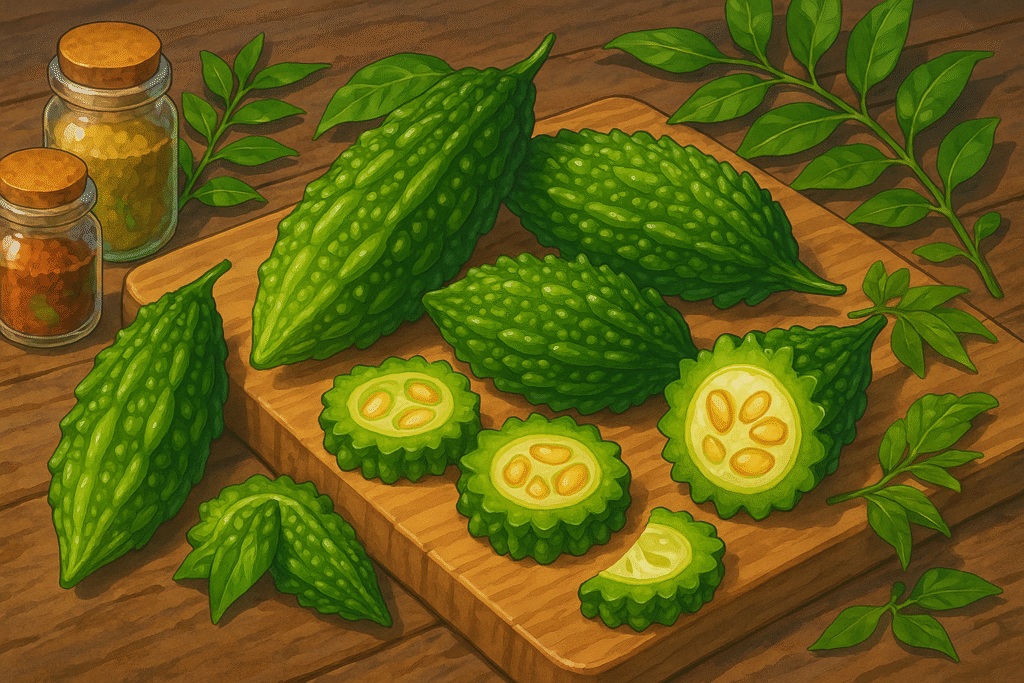Bitter Melon (Bitter Gourd) (Momordica charantia)

About Bitter Melon (Bitter Gourd)
Bitter melon, also called bitter gourd, is a tropical fruit masquerading as a vegetable. It’s sharply bitter, cucumber-like in texture, and uniquely medicinal in flavor. Though polarizing, it’s a beloved ingredient in Indian, Chinese, Southeast Asian, and Caribbean cuisines.
Whether stir-fried, stuffed, curried, or steeped in tea, bitter melon is celebrated more for its health benefits and complex taste than its immediate appeal.
The History of Bitter Melon (Bitter Gourd)
Bitter melon has been used for over 600 years, first in India and later throughout Asia and Africa. Ayurvedic and traditional Chinese medicine praised it for detoxifying the body, aiding digestion, and regulating blood sugar.
It spread along trade and colonial routes to East Asia, the Philippines, the Caribbean, and Brazil, where it was incorporated into both folk remedies and everyday meals.
Despite its bitterness, it gained popularity in working-class cuisines for its affordability, abundance, and ability to stretch bold flavors in frugal dishes.
The Science of Bitter Melon (Bitter Gourd)
Bitter melon contains charantin, vicine, and polypeptide-p — compounds studied for blood sugar regulation. It also includes momordicin, which gives it that unmistakable bitterness and potential anti-inflammatory properties.
Its ridged skin and spongy center make it sponge-like when cooked — absorbing flavors while retaining its signature edge. Raw seeds are usually removed, especially once they turn red.
The Geography of Bitter Melon (Bitter Gourd)
It grows in tropical and subtropical zones, including India, China, Southeast Asia, Africa, the Caribbean, and parts of South America.
In India and Sri Lanka, it’s fried or simmered in spicy masalas. In the Philippines, ampalaya is used in stir-fries and soups. In Okinawa, it stars in goya champuru, a stir-fry associated with longevity.
Varieties of Bitter Melon (Bitter Gourd)
Indian Bitter Melon
Slender with deep green color and rough, warty skin. Intensely bitter and commonly used in curries and fried dishes.
Chinese Bitter Melon
Larger, lighter green, with a smoother, ridged surface. Milder in bitterness and often used in stir-fries and soups.
White Bitter Melon
A rare variety with pale skin and a slightly milder taste. Popular in Taiwan and used in medicinal broths.
Thai Bitter Melon
Long, slightly curved with gentle ridges. Often stuffed with pork and simmered in clear soups.
Okinawan Goya
Medium bitterness and firm texture — central to Okinawan champuru stir-fries and health-focused diets.
FAQs All your questions about Bitter Melon (Bitter Gourd): answered
Is bitter melon safe to eat raw?
Yes, but it’s extremely bitter and best consumed in moderation. Some cultures juice it for medicinal use.
How do you reduce the bitterness?
Salt the sliced melon and let it sit, then rinse. Parboiling also helps mellow the intensity.
What does bitter melon taste like?
Sharp, vegetal, and medicinal — an acquired taste often compared to very bitter cucumber with herbal notes.
Is bitter melon really good for you?
It’s rich in compounds linked to blood sugar control, digestion, and liver health, but should be eaten in balanced amounts.